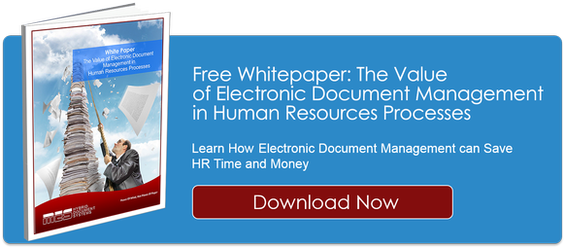 Human Resource management is a multi-faceted organizational challenge. Along with talent acquisition and retention, HR departments are faced with the tasks of electronic HR records management, meeting government regulated compliance standards, as well as meeting time sensitive payroll processes.
Human Resource management is a multi-faceted organizational challenge. Along with talent acquisition and retention, HR departments are faced with the tasks of electronic HR records management, meeting government regulated compliance standards, as well as meeting time sensitive payroll processes.
With so many responsibilities falling onto the HR department, inefficiencies tend to surface, particularly in regards to paperwork and administrative burdens, delayed payment, review and approval processes, and even in the hiring process itself. These inefficiencies stem primarily from a common underlying issue: outdated HR records management.
For organizations wishing to curtail their HR records management challenges, the following advice is a step in the right direction. Here is our unconventional guide to electronic records management for HR.
Paperless HR: Is it Possible?
Absolutely. However, paperless HR records management is not yet a widespread initiative (though it should be). Paper systems still exist in many organizations, and in cases where they are set up correctly, they comply with the law and get the job done. That said, paper-based systems come with inherent issues. For one, they require substantial time and resources to create and maintain. Additionally, from an information retrieval perspective, they incur significant costs. And because such systems are only as good as the people using them, they are susceptible to human error including record mismanagement or improper filing.
The first step towards eliminating such inefficiencies in your HR records management is to adopt a paperless (or at least, a primarily electronic) system to replace resource-heavy paper systems.
HR Records Management Automation
Paperless HR is one thing; but adopting a paperless HR records management system that also helps automate particular processes is a huge time and money saver. Consider some of the HR processes you currently undertake, and how they can be streamlined, improved and made more flexible and cost effective by automated systems. For example, recruiting and onboarding new employees, compliance to government standards, payroll processes, and review/approval processes can likely be improved using HR automation software. This not only boosts productivity and outputs, but also serves to save organizations money by allowing key employees to focus on their core business processes.
The following are some demonstrable benefits of adoption a paperless HR records management software:
-
Capture, sort and distribute applications and resumes automatically
-
Automate payroll and expenses processes
-
Improve information retrieval functionality
-
Boost information security
-
Automate record retention and destruction schedule
-
Improve legal compliance
In the end, improving HR records management can have a ripple effect, eliminating many HR issues at their origin. Whether your organization is experiencing inefficiencies in time sensitive payroll processes, talent acquisition and retention, labour compliance, or beyond, moving to a paperless HR automation solution can significantly increase the performance of your Human Resource department.

